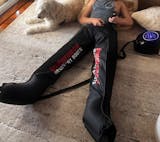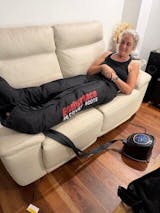Can Compression Boots Help with Shin Splints?

Ready to wave goodbye to the agony of shin splints? Compression boots might just be your game-changer. Imagine a world where post-workout discomfort is a thing of the past. With compression boots, recovery becomes a breeze – no more enduring pain when you could be reveling in relief. Say hello to quicker recovery times and reduced muscle soreness, all while kicking those pesky shin splints to the curb.
Understanding shin splints
Benefits of Using Compression Boots
Compression boots can aid in relieving shin splint discomfort by enhancing blood circulation and reducing inflammation. The pressure applied by the boots helps decrease swelling, promoting faster recovery from shin splints. By improving blood flow, compression boots assist in delivering essential nutrients to the affected area, supporting healing.
Wearing compression boots after a strenuous workout or activity that triggers shin splint pain can be beneficial. These devices offer convenience as they can be used at home while relaxing, making them a practical solution for managing shin splint symptoms effectively. Compression therapy through these boots may prevent future occurrences of shin splints by supporting muscle recovery and reducing strain on the lower leg.
Considerations When Using Compression Boots
While compression boots help manage shin splints, it's essential to ensure proper usage to maximize their benefits. Correct fitting is crucial to achieve optimal results; too tight or loose compression may not yield the desired outcomes. It's advisable to follow manufacturer guidelines regarding wearing duration and pressure settings when using these devices.
Moreover, individuals with certain medical conditions such as peripheral neuropathy or deep vein thrombosis should consult healthcare professionals before using compression boots for treating shin splints. Understanding one's specific health needs and any underlying issues is key to safe and effective use of this recovery tool.
Causes and symptoms of shin splints
Causes
Shin splints, often triggered by excessive running or jumping on hard surfaces, can also result from factors like wearing improper footwear. Muscle imbalances play a significant role in the development of this condition. When muscles in the legs are overworked due to repetitive stress, they can lead to inflammation along the shinbone.
-
Excessive running or jumping
-
Improper footwear
-
Muscle imbalances
Shin splints can be compared to a car's suspension system - if one part is out of alignment or under too much pressure, it affects the entire mechanism's smooth functioning. Similarly, when activities like running or wearing unsupportive shoes place excessive strain on leg muscles without adequate rest, it disrupts their balance and causes discomfort.

Symptoms
The hallmark signs of shin splints are pain, tenderness, and swelling along the inner part of the lower leg where the bone is located. This pain may start as a dull ache during physical activity but can progress to sharp throbbing even at rest. Swelling occurs due to inflammation caused by microscopic tears in the muscles surrounding the shinbone.
-
Pain
-
Tenderness
-
Swelling
Imagine your body as an orchestra - each muscle playing its part harmoniously until one section starts playing off-key. Shin splint symptoms act as discordant notes disrupting your body's symphony; causing discomfort that needs attention before it turns into a major injury.
Role of compression in healing
Reduction of Swelling and Promotion of Blood Flow
Compression boots for shin splints work by applying pressure to the affected area. This pressure helps to reduce swelling, which is a common symptom of shin splints. By reducing swelling, compression therapy allows for better blood circulation in the injured area.
Compression garments play a crucial role in promoting blood flow to the affected muscles and tissues. Improved blood circulation aids in delivering essential nutrients and oxygen to the damaged shins, facilitating the healing process. As a result, wearing compression boots can help alleviate pain associated with shin splints.
Support for Muscles and Tissues
Compression therapy not only focuses on reducing swelling but also provides vital support to the muscles and tissues surrounding the shins. By offering this support, compression garments help decrease stress on the shins during physical activities like running or jumping, which are common triggers for shin splints.
-
Compression therapy reduces swelling
-
Promotes blood flow for faster healing
-
Provides support to muscles and tissues around the shins
Compression boots and shin splints
How compression boots help
Compression boots, a form of compression therapy, are designed to cover the entire lower leg. They work by providing intermittent pneumatic compression which aids in enhancing blood flow and reducing inflammation. By promoting circulation, these boots can effectively alleviate symptoms associated with shin splints such as pain and discomfort.
Compression boots offer an excellent alternative for treating shin splints compared to traditional methods like rest or icing. The gentle pressure exerted by the boots helps in decreasing swelling and soreness in the legs caused by overuse during activities like running or sports training. For individuals suffering from persistent shin splint issues, incorporating compression boot therapy into their recovery routine can significantly improve healing time.
-
Provides intermittent pneumatic compression
-
Enhances blood flow and reduces inflammation
-
Alleviates pain associated with shin splints
Effectiveness of compression boots
Athletes, especially runners, who frequently experience leg pain due to conditions like shin splints have found relief through the use of compression boots. These devices have become popular among both professional athletes and youth athletes looking to recover quickly from injuries sustained during sports activities.
-
Speeds up the recovery process for athletes
-
Reduces swelling and discomfort in the legs
-
Improves overall performance during workouts
Scientific evidence supporting compression therapy
Pain Reduction and Improved Function
Studies have demonstrated that compression therapy is effective in alleviating pain and enhancing functionality for individuals suffering from shin splints. The application of compression garments can lead to a significant decrease in discomfort, allowing individuals to engage in physical activities with reduced hindrance. This improvement not only enhances the overall quality of life but also aids in maintaining an active lifestyle.
Research findings indicate that compression garments play a crucial role in boosting muscle oxygenation while decreasing muscle damage when engaging in physical exercise. By promoting better blood flow and circulation, these garments help muscles receive adequate oxygen supply, reducing fatigue and enhancing performance during workouts or sports activities.
Accelerated Recovery Time
Athletes experiencing shin splints can benefit from the expedited recovery time facilitated by compression therapy. This form of treatment has been observed to quicken the healing process, enabling athletes to return to their training routines sooner than expected. By aiding in tissue repair and reducing stress on the affected area, compression therapy proves instrumental in ensuring athletes resume their sporting activities swiftly.
Expert opinions on compression for shin splints
Benefits of Compression Therapy
Compression therapy, a crucial component in treating shin splints, is highly recommended by experts. Compression boots or garments aid in managing symptoms and accelerating the healing process. The use of compression helps reduce inflammation and muscle soreness associated with shin splints. Athletes benefit from improved blood circulation due to the pressure applied by compression gear.
Healthcare professionals endorse this therapy as it provides support to the lower leg muscles during physical activities, reducing strain on the shins. Compression boots offer targeted pressure that can alleviate pain and discomfort caused by shin splints. By incorporating compression into their routine, individuals may experience faster recovery times from injuries.
Considerations for Athletes and Trainers
Athletes often turn to compression therapy not only as a treatment but also as a preventive measure against future injuries like shin splints. By using compression garments, individuals can maintain optimal muscle function while engaging in sports or workouts, thus minimising the risk of developing overuse injuries such as shin splints.
-
Provides support to lower leg muscles
-
Reduces inflammation and muscle soreness
-
Improves blood circulation
Practical advice on using compression boots
Choosing the right size and fit
Compression boots for shin splints must be the correct size to work effectively. Ill-fitting boots can cause discomfort or reduce their benefits. Ensure a snug but not tight fit.
When selecting compression boots, consider your calf circumference and shoe size. Proper measurement ensures optimal blood flow restriction without causing any discomfort or hindering circulation.
-
Correct sizing enhances the effectiveness
-
Snug fit prevents discomfort during use
Regular wear and maintenance
To benefit from compression boots for shin splints, wear them consistently, especially during activities or when experiencing pain. Consistent use helps manage symptoms effectively over time.
Regularly clean your compression boots according to the manufacturer's instructions to maintain hygiene and ensure longevity. Proper care prolongs the lifespan of the boots while keeping them fresh for each use.
-
Wear regularly during activity or pain
-
Clean as per manufacturer's guidelines for longevity
Incorporating compression boots into treatment plans
Additional Treatment Options
Compression boots can complement other treatments like rest, ice, and physical therapy for shin splints. This combined approach helps in managing pain and promoting faster recovery from the injury. By incorporating compression boots into the treatment plan, individuals can experience enhanced relief and accelerated healing.
When used alongside traditional methods, such as rest and icing, compression therapy with boots proves beneficial. The controlled pressure applied by the boots aids in reducing inflammation and swelling associated with shin splints. Thus, it plays a crucial role in expediting the overall recovery process.
Gradual Activity Increase
Healthcare professionals can offer valuable insights on how to integrate compression boot sessions effectively into a patient's recovery routine. They guide patients on the optimal frequency and duration of each session to maximize benefits while minimizing any risks or discomfort. Gradually increasing activity levels while wearing compression boots can aid in strengthening muscles affected by shin splints.
-
Compression therapy enhances blood circulation.
-
Combining different treatments leads to comprehensive care.
-
Controlled unit settings ensure tailored therapy sessions.
Final Remarks
You've delved deep into the realm of shin splints and how compression boots can be a game-changer in your recovery journey. From understanding the ins and outs of this common issue to exploring the science-backed benefits of compression therapy, you're now equipped with the knowledge to take charge of your healing process. Expert insights have shed light on the effectiveness of compression boots, and practical tips have shown you how to seamlessly integrate them into your treatment plan.
Now it's time to lace up those compression boots and kick shin splints to the curb! Take the advice you've gathered here and make it work for you. Embrace the power of compression, stay consistent with your routine, and watch as those pesky shin splints become a thing of the past. Your journey to pain-free runs starts now!
Frequently Asked Questions
How do compression boots help with shin splints?
Compression boots can aid in reducing inflammation, improving blood flow, and providing support to the muscles around the shins. This can help alleviate pain and promote faster recovery from shin splints.
Are compression boots a suitable treatment for shin splints?
Compression boots are considered a beneficial part of the treatment plan for shin splints. They can complement other therapies like rest, ice, stretching, and strengthening exercises recommended by healthcare professionals.
When should I use compression boots for shin splints?
It is advisable to wear compression boots after physical activity or when experiencing symptoms of shin splints such as pain or tenderness in the lower leg area. Using them during recovery periods can also be beneficial.
Can anyone use compression boots for shin splints?
While generally safe for most individuals, it's recommended to consult with a healthcare provider before using compression boots if you have underlying health conditions like deep vein thrombosis (DVT) or peripheral arterial disease (PAD).
How long should I wear compression boots each session?
Starting with around 30 minutes to an hour per session is typically advised when using compression boots for shin splint relief. Gradually increase the duration based on comfort levels and recommendations from healthcare providers.
Research Articles:




